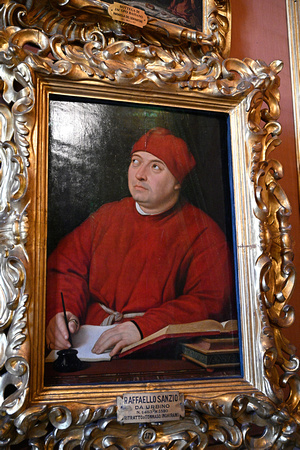Portrait of Tommaso Inghirami is an
oil painting by Italian artist
Raphael. Painted ca. 1509, it exists in two copies, one of which is in display in the
Palatina Gallery of
Palazzo Pitti in Florence and the other in the
Isabella Stewart Gardner Museum in
Boston.
[1] Known for its realism and attention to detail, the image is reminiscent of works by
Hans Holbein the Elder, by whom Raphael may have been influenced in its execution.
[2] Stylistically, it relates to Raphael's
Portrait of Agnolo Doni, ca.1506, in what Claudio Strinati described in 1998 as its "merciless clarity."
[1]The subject of the painting,
Tommaso Inghirami, was a friend of Raphael's, a
prelate nicknamed
Phaedra following a skillful exhibition of Latin poetry improvisation during a performance of
Seneca's
Phaedra wherein he carried the title role.
[2] A popular orator and actor, Tommaso Inghirami had
strabismus.
[3]According to 2005's
Cambridge Companion to Raphael, the piece is "the first likeness into which Raphael introduced the concept of movement", in the twist of his body as he contemplates his composition.
[4] By means of this device, Raphael focused attention away from his subject's disfigurement
Portrait of Tommaso Inghirami is an
oil painting by Italian artist
Raphael. Painted ca. 1509, it exists in two copies, one of which is in display in the
Palatina Gallery of
Palazzo Pitti in Florence and the other in the
Isabella Stewart Gardner Museum in
Boston.
[1] Known for its realism and attention to detail, the image is reminiscent of works by
Hans Holbein the Elder, by whom Raphael may have been influenced in its execution.
[2] Stylistically, it relates to Raphael's
Portrait of Agnolo Doni, ca.1506, in what Claudio Strinati described in 1998 as its "merciless clarity."
[1]The subject of the painting,
Tommaso Inghirami, was a friend of Raphael's, a
prelate nicknamed
Phaedra following a skillful exhibition of Latin poetry improvisation during a performance of
Seneca's
Phaedra wherein he carried the title role.
[2] A popular orator and actor, Tommaso Inghirami had
strabismus.
[3]According to 2005's
Cambridge Companion to Raphael, the piece is "the first likeness into which Raphael introduced the concept of movement", in the twist of his body as he contemplates his composition.
[4] By means of this device, Raphael focused attention away from his subject's disfigurement
Portrait of Tommaso Inghirami is an
oil painting by Italian artist
Raphael. Painted ca. 1509, it exists in two copies, one of which is in display in the
Palatina Gallery of
Palazzo Pitti in Florence and the other in the
Isabella Stewart Gardner Museum in
Boston.
[1] Known for its realism and attention to detail, the image is reminiscent of works by
Hans Holbein the Elder, by whom Raphael may have been influenced in its execution.
[2] Stylistically, it relates to Raphael's
Portrait of Agnolo Doni, ca.1506, in what Claudio Strinati described in 1998 as its "merciless clarity."
[1]The subject of the painting,
Tommaso Inghirami, was a friend of Raphael's, a
prelate nicknamed
Phaedra following a skillful exhibition of Latin poetry improvisation during a performance of
Seneca's
Phaedra wherein he carried the title role.
[2] A popular orator and actor, Tommaso Inghirami had
strabismus.
[3]According to 2005's
Cambridge Companion to Raphael, the piece is "the first likeness into which Raphael introduced the concept of movement", in the twist of his body as he contemplates his composition.
[4] By means of this device, Raphael focused attention away from his subject's disfigurement
Portrait of Tommaso Inghirami is an
oil painting by Italian artist
Raphael. Painted ca. 1509, it exists in two copies, one of which is in display in the
Palatina Gallery of
Palazzo Pitti in Florence and the other in the
Isabella Stewart Gardner Museum in


